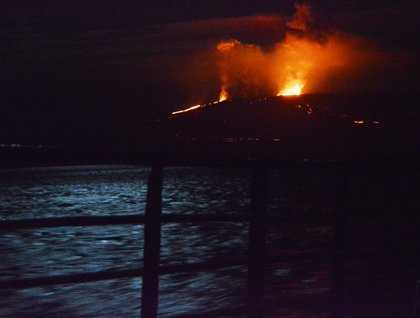Today we arrived to Santa Maria, otherwise known as Floreana Island, and the ship was buzzing with anticipation. Very early this morning, our deck officer and some of the naturalists onboard the National Geographic Endeavour spotted the glare of what was reported next morning in social media as a “large explosive-effusive eruption” from Wolf Volcano, on Isabela Island. So our visit to Floreana today was full of volcanic stories. We had a pre-breakfast outing to enjoy the sunrise light in Punta Cormorant, and the pacific green turtle nesting site on it. Our day was quite colorful, as more than 50 flamingos, an outstanding number for Galapagos, were present in Floreana lagoon, getting ready for the mating season. The sight was fantastic, as was the contrast between the green sand we met upon arrival, made of the semiprecious stone peridot, and the fine powdery white sand of Flour Beach, at the end of the walk. Beauty surrounded us, and it was difficult to choose where to look!
After breakfast, we navigated around the peninsula and anchored near by a small island, called Champion Island. Our aim was to discover the underwater richness of this area, and we had the option of exploring from a dry vantagepoint, in our glass-bottom boat, or by jumping in and getting wet! The findings were awe-inspiring, we were surrounded by sharks, green turtles, scorpion fish, and a massive school of black-striped salemas that shadowed the bottom of the sea!
Lunch followed, and our third navigation took us to the northern part of the island, to a historical place known as Post Office Bay. There we had the opportunity to participate in a centuries-old tradition, of taking mail from a long-standing post office barrel and delivering it to wherever in the world was sent to. The afternoon was beautiful and sunny—a perfect scenery for some extra navigation, due north, to peak in on the volcanic activity. A deviation from our normal itinerary gave us the most incredible view: A shield volcano of 5,610 feet, Wolf, had a number of fissures fountaining red hot lava towards the southern face. I witnessed the last eruption of Wolf, as a child in 1982, while the previous one had taken place back in 1797, so this was really something worth watching! The glow of lava could be seen many miles away, and the 6 x 7 km caldera had a huge cloud of dust and gas that looked like a gigantic oil lamp. The summit was cracked into various radial fissures, all of them spouting glowing molten rock. It was an epic sight! Wolf's 1797 eruption was the first documented historical eruption in the Galápagos Islands. We can only imagine the conditions back then, on land and the nearby shore, blazing hot material flowing everywhere. Most of us stayed up late, enjoying the views out on deck, as our ship broke the waters back to our next destination. Another day in Paradise…







